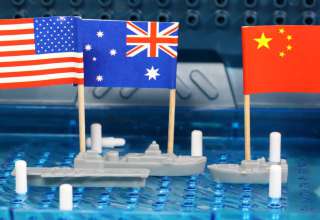Speech at Independent and Peaceful Australia Network Adelaide Rally
22 September
by Stephen Darley
Convenor IPAN (SA)
What’s the difference between 10,000 people being killed in air strikes and a bunch of missiles taking out an oil processing facility?
The difference is that only the one which threatens the markets will “not be tolerated” by the Trump administration.
Scott Morrison, PM of Australia is in the US exploring how far he can kis Donald Trump’s bum. Morrison is following a long tradition – remember Harold Holt’s “all the way with LBJ” as the Vietnam War built up? So will this be part of the preliminaries to a new war, against Iran?
This is a very real possibility: but things are changed from those Vietnam days (the 50th anniversary of the Moratorium in Australia is next year). The events of the last week illustrate that change very well – as well as the continuity. In 1966 the US was arrogant, convinced it was special – the exceptional nation in fact – well, it’s leaders still believe that of course! In a few short years it threatened to “bomb Vietnam back to the stone age”.
But it failed, and lost the war, in the only way such powerful states usually lose such wars – through asymmetric warfare not on their terms which exhausts their willingness to persist. The same thing is now happening to Saudi Arabia and their chief sponsors the US in Yemen.
The attack on the Saudi oil facilities was epoch-making in some ways. Remember Mao Zhedong’s phrase: “All reactionaries are paper tigers. In appearance, the reactionaries are terrifying, but in reality they are not so powerful.” Well, not only the Saudis but the US has been shown up as a paper tiger by the attacks on the Saudis – still very powerful, but also very vulnerable.
Because what have the Saudis been spending hundreds of billions of dollars on for decades now? The products of the US military industrial complex, including the much-vaunted Patriot missile defence system. And a handful of $20,000 drones have slipped past them! States and non-state actors in conflict or potential conflict with the US will take note.
”Patriot missiles failed to protect Saudi Arabia from attack because even the world’s best anti-air systems sometimes don’t work”, Secretary of State Mike Pompeo has said.
This is the major reason they must blame the Iranians, not the Houthis. Because if a hill-tribe people from one of the poorest countries on earth, suffering after 4 years of brutal and merciless aerial bombardment, can do this….! The paper tiger has been thoroughly battered by wind and rain.
The US doesn’t need a justification for attacking Iran – in their eyes they have had plenty. But the truth is the US military and others have been advising Donald Trump that a war with Iran would be very costly indeed, above all in money and votes (in next year’s presidential election) – former Defence Secretary Leon Panetta being the latest, saying “As a minister, I have always been concerned over the possibility of launching a military campaign on Iran, as it will look nothing like our strike against Syria. Iran has the ability to use missiles to hit our forces, respond with targeting our bases and rapidly transform and escalate the war.”
In fact, the US 5th Fleet in Bahrain is almost a hostage to US war plans. It’s been known for some time that US Aircraft carriers are in some ways obsolete but mind-bogglingly expensive targets for Chinese and Russian hypersonic missiles. Iran does not have these, but they can use swarm attacks to swamp US defences. This is why other US naval forces, including another $5 billion-dollars-worth super-carrier, the USS Abraham Lincoln, have remained in the Arabian Sea, not entering the Persian Gulf. This is because these are very constricted waters, varying from 180 to 35 miles wide at their narrowest, in the Straits of Hormuz, and the Iranians have hundreds of miles of coastland to deploy their mobile missile batteries in.
Of course, such a war would cause enormous suffering in Iran – but US sanctions have already caused much of that, and Iranians, even those many who have no love for the Ayatollahs, have a great deal of pride and love for their ancient civilisation and present nation, and nearly all of their 80 million people would strongly resist any US attack.
This Houthi attack has also struck a crippling blow to the credibility of one of the US two main allies in the Middle East, Saudi Arabia, and undoubtedly alarmed Israel, the other. Hezbollah in Lebanon is much better armed than the Houthis, and is likely to aid Iran in any attack on them.
Saudi Arabia is basically a fictional state, cobbled together after WW1 by the (now dis-) United Kingdom from several quite different Ottoman Empire provinces, and put under the control of almost literally the leader of camel herders and traders in the oasis of Riyadh – the Ibn Saud family. Already one of the most brutal and intolerant states on earth, the Saudis doubled the number of executions they carried out last year.
Undoubtedly some were horrible medieval left-overs like the “crime” of sorcery, or of women who dared to challenge their patriarchy, but most were attempted suppression of the large Shiite population in eastern Arabia, around the main oilfields and the shores of the Persian Gulf. The Houthis have already hinted at receiving local support for their attack on the oilfields perhaps in targeting, although 120 -metre wide tanks and large refining towers are not the hardest of bulls-eyes.
Some even on the left have condemned the attacks, in terms of the impact on the global economy. But why should the recipients of unrelenting airstrikes on schools and school buses, water and food infrastructure, and a genocidal blockade that threatens millions with starvation care about that, when the world hasn’t stopped their suffering?
The Houthis have now said they will no longer target such facilities – if the Saudi’s reciprocate. If MBS, their de-facto leader, has any brains, he will do so – or face the possible end of his regime. This may be a vain hope, however, as the Saudi’s (and the UAE) have now agreed to participate in the US gunboat diplomacy in the Straits of Hormuz, which even they have resisted until now.
But I suppose if the military guarantor of your regime really twists your arm, you have to fall in line. Australia the useful fool didn’t even need this – like a fawning lap-dog our government leapt to join in this provocative and highly dangerous exercise. The other eager participant is the disunited Kingdom, under that idiot’s guide to Winston Churchill, Boris Johnson. Doing his best to split the last remnants of the faded empire apart, he desperately wants a US trade deal to rescue the economy after a no-deal Brexit – so he’s just a bigger lapdog to his big brother Donald.
Trump is still saying he will stick with sanctions for now, despite blaming Iran for the oil strikes – but whist the sacking of John Bolton as NSAdviser probably signals a reduction of the probability of a deliberate provocation, the whole US-led patrolling of the Straits of Hormuz makes the possibility of an unintended clash as strong as ever. Half the Straits (remember only 50 km wide) are Iranian territorial waters, and the Iranians have made it clear if there is any interference in their oil tankers traversing the straits, they will close them down for everyone – indefinitely.
Meanwhile Iran is doing all it can to reduce the impacts of the sanctions, and the Russians and Chinese are actively helping the Iranian oil sales – whilst advancing efforts to undermine the US dollar as the default currency of such sales globally. This would critically damage the US economy and particularly their arms production and military bases funding – only by the dollar-oil connection is the US able to run such huge deficits – currently over $1 trillion dollars, which is only slightly larger than their record total military spending, greater than those of the next 10 largest government expenditures combined.
This shows how Trumps isolationist policies from 2016 election have faltered, although he hasn’t yet started a new war. Meanwhile the mainstream Democrats are just as war-mongering as they were in 2016. China has become the chief enemy of both sides of establishment US politics now, which brings us back to Australia and the Asia-Pacific.
US military strategy here is now focused on a kind of updated island-hopping policy, as in WW2, and the marines in the NT are an integral part of that strategy. The naval base the ABC reported 2 months ago they to wanted to build near Darwin (because of Congressional committee evidence) now appears to be an allocation for an Osprey air base. Ospreys are the Vertical Take-Off and Landing transport planes which would carry Marines at Darwin to targets such as Pacific islands. The latest rocket artillery support for such attacks were used during the recent Talisman Sabre large-scale joint military exercise in Queensland, and 2 of those rocket batteries have been left behind – no doubt to familiarise Australian troops with their use, as well as the marines.
And the next big US – Australian military integration is undoubtedly the stationing of intermediate-range missiles in the NT, capable of reaching southern China, as discussed at the August AUSMIN talks with Secretary of State Pompeo, and very likely in the US now between Morrison and Trump and their advisors.
Such missiles would have been banned under the INF treaty which the US withdrew from last year – and China was a key reason for that withdrawal, as they were not part of the treaty. Such missiles are the successors to the US and Soviet missiles which caused the massive expansion of the global and particularly European peace movement in the 1980’s, and undoubtedly will be, like those, nuclear-capable.
Australia’s peace movement also rapidly grew in that era, with which I personally got involved – through PND (SA). I hope we can do it again if necessary, but it would be a high price to pay to be involved in such escalation of global tensions.
I want to finish with a couple of key points from Brian Toohey’s new book, SECRET, the making of Australia’s security state. The veteran Toohey is one of the most honest and forthright exceptions to Australia’s generally compliant and conservative mass media operators.
“A US president presides over a military-industrial-intelligence complex with a huge say in whether Australian governments go to war, buy particular weapons, host US-run military and intelligence bases and ban trade with certain countries. The upshot is that Australia has now surrendered much of its sovereignty to the US.
The US requires almost all countries that buy its weapons systems to send sensitive components back to the US for repairs, maintenance and replacements without the owners being allowed access to critical information, including source codes, needed to keep these systems operating. As far back as August 2001, a Parliamentary Library research paper concluded that it was “almost literally true that Australia cannot go to war without the consent of the US”. Since then, Australia has become much more dependent on US support for far more complex systems. As a result, Australia could be defenceless if attacked, unless the US allows the defence force independent access to key operational components of fighter planes, missiles, submarines and surveillance systems.”
Shortly after returning from a six-year posting as Australia’s Washington ambassador in 2016, Kim Beazley [former ALP leader and defence minister] gave a speech sponsored by Lockheed Martin which had appointed him to its Australian board. He happily admitted that he was a member of a “deep state”, but not an evil one where “the real power lies in a military/intelligence phalanx”. He belonged to what he called a “benign deep state”. “Benign” is not obvious description of what Beazley’s deep state did to Korea, Vietnam, Iraq and Afghanistan or to elected leaders such as Iran’s Mohammed Mossadegh, the Congo’s Patrice Lumumba or Chile’s SalvadorAllende.
Beazley said the Americans wanted to move beyond “interoperability” of the two countries military forces to “integration” in which the US will sometimes want to use our equipment. He gave an example of US Marines using a big amphibious Australian ship, leaving the Australian navy unable to deploy it at short notice to meet Australia’s own needs in critical circumstances. More broadly, integration means that Australian equipment and troops will be able to ‘plug’ straight into US forces when a new war erupts.“
This is where we are now – conflict is brewing globally and in our region, and Australia has very little sovereignty when it comes to involvement. We are spending at least $200 billion on military equipment over 10 years, most of it designed as Toohey says to ‘plug’ into US forces, not to defend Australia. And to reiterate, the real problems are thus neglected – growing inequality, social and economic needs, and of course climate change.
How good is that?!







